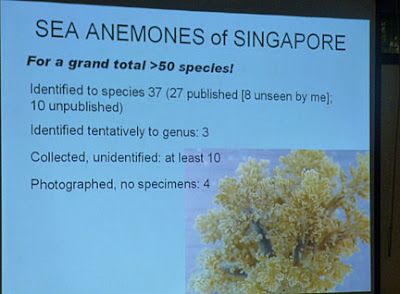Dr Daphne Fautin, world authority on sea anemones, gave another talk yesterday to a smaller but equally enthusiastic group!This time, she goes into more detail about how sea anemones are identified and why they are important to Singapore.
Jonathan Ngiam started off the talk by sharing his experience as a participant of Dr Daphne's recent Sea Anemone workshop. It's hard work identifying sea anemones!
In this talk, Dr Daphne gives more insights on some aspects of our sea anemones.
Why would we want to know what kinds of sea anemones can be found in Singapore? For herself, Dr Daphne is intrigued by the biology of our sea anemones and their occurrence in Singapore as part of their global distribution. For us who love wild life, it would be part of our fascination with our natural history, sharing it with others and also conserving our heritage.
Dr Daphne briefly recaps the amazing diversity of sea anemones that can be found on our shores. Some of them, she has yet to see for herself! We must redouble our efforts to correct this gap!
Dr Daphne highlights some interesting sea anemones such as the Snaky sea anemone (Macrodactyla doreensis). She was delighted to discover that it is common on our shores. Singapore is the Western most occurrence of this species. She suggests on of the reasons for Singapore's diverse anemones is that we are at the cross-roads between the Pacific and Indian Oceans.
Dr Daphne shared some insights on sea anemones that she most recently identified. The beautiful burgundy anemones she has very quickly identified as Bunodosoma goanensis. The Anemone Army is not the first to highlight these anemones' presence in Singapore to her as she had earlier received photos of it occurring on our buoys! She shares more about the global distribution of this sea anemone. Tomorrow, we hope to show her these anemones at Punggol!
Dr Daphne reveals that the Workshop has identified "Bob the Blob" as Paracondylactis sinesis! Hurray!
Closer study is necessary to help us better understand our sea anemones. For example, one of the most widespread sea anemones in Singapore is this tiny striped sea anemone that was thought to only live on a particular kind of snail. But from our field explorations, we discovered they also cling on to other kinds of snails, and may also be found just in the ground not attached to a snail.
Dr Daphne is most fascinated by this tiny sea anemone with amazing spots. She first saw this just as we were finishing up our survey of Sungei Buloh on her previous trip two years ago. On this trip, she found them at other locations nearby. And during the Workshop, observed them 'fighting' with specialised stinging tentacles! Its identity has yet to be figured out!
Many of our sea anemones can look very similar at first glance in the field. Dr Daphne is personally interested in allowing identification of live sea anemones in the field. But this means she must first do the hard work of looking at live sea anemone, then studying samples more closely in the laboratory to be sure of their identity.
It's tricky trying to identify sea anemones, Dr Daphne explains. Some sea anemones like the Frilly sea anemone (Phymanthus sp.) come in a bewildering variety of patterns and colours. Many similar anemones have been given names, from several locations near Singapore. We need to examine our sea anemones more closely to be sure.
To be sure of a sea anemone's identity we have to look at their insides. We need to get samples from different locations, at different times. These have to be preserved in different ways. One way to get a closer look at their tissues. Another way to be able to study their DNA. Among the finicky and tedious things that need to be done is to study their tiny tiny stingers, as she explained in this earlier talk during the Workshop.
Dr Daphne and Dr Tan Swee Hee have brought some examples of preserved sea anemones and results of tissue work for participants to have a closer look.
Of course Dr Daphne covered lots more, including a recap of some of the key points of her public lecture.
After her talk, there was a lively Q&A session, followed by look at the samples of sea anemones resulting from the workshop.
It was fascinating to take a closer look at these animals and how they are identified.
Andy Dinesh once again video taped Dr Daphne's talk. So if you missed it you can catch up on her talk once he uploads the clip. Thank you Andy!
Tomorrow, the anemone hunt resumes with Dr Daphne and the Anemone Army! This time to Punggol!

















